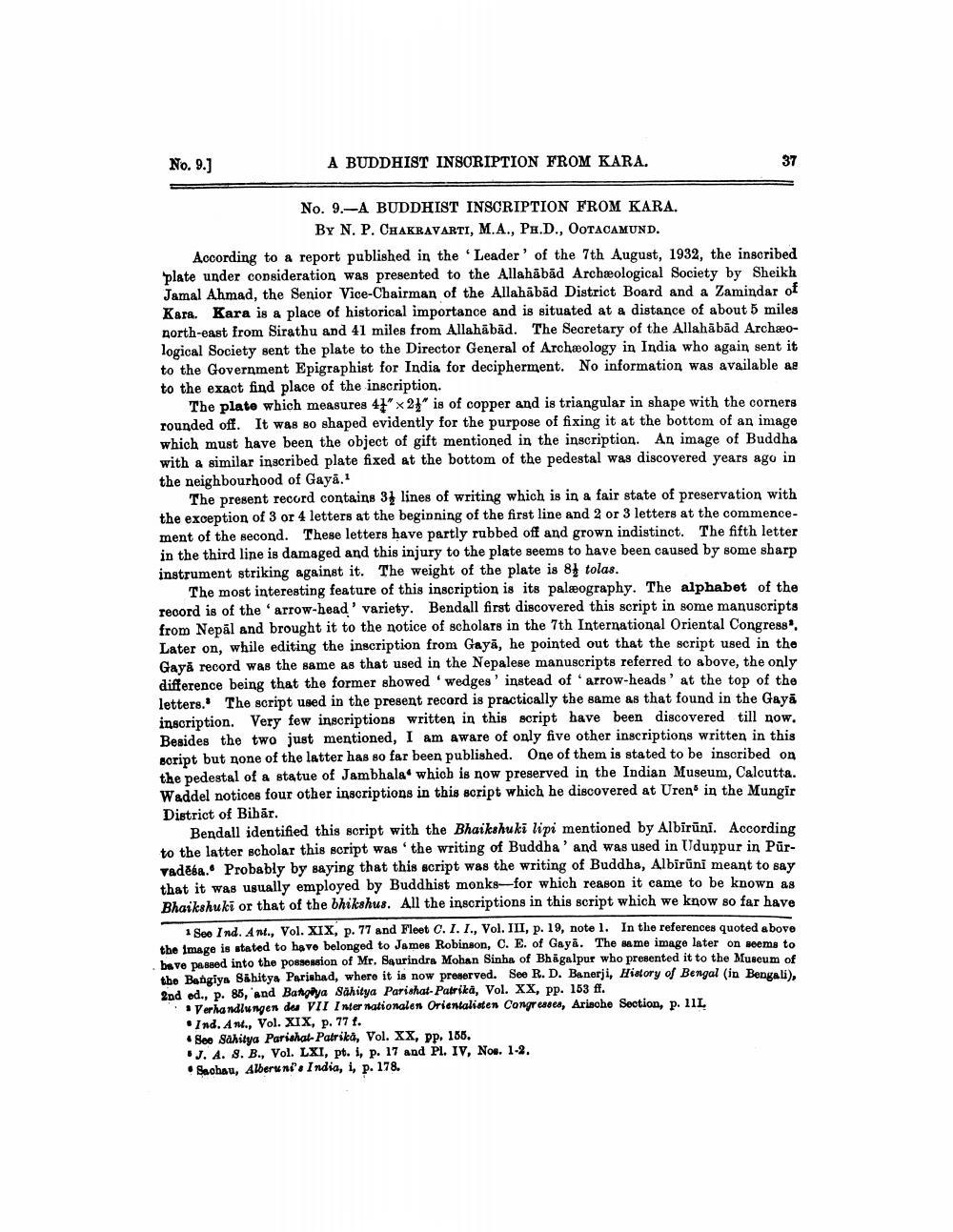________________
No. 9.]
A BUDDHIST INSCRIPTION FROM KARA.
No. 9.-A BUDDHIST INSCRIPTION FROM KARA.
BY N. P. CHAKRAVARTI, M.A., PH.D., OOTACAMUND. According to a report published in the 'Leader of the 7th August, 1932, the inscribed plate under consideration was presented to the Allahābād Archæological Society by Sheikh Jamal Ahmad, the Senior Vice-Chairman of the Allahābād District Board and a Zamindar of Kara. Kara is a place of historical importance and is situated at a distance of about 5 miles north-east from Sirathu and 41 miles from Allahābād. The Secretary of the Allahābād Archæological Society sent the plate to the Director General of Archæology in India who again sent it to the Government Epigraphist for India for decipherment. No information was available as to the exact find place of the inscription.
The plate which measures 47" x 21" is of copper and is triangular in shape with the corners rounded off. It was so shaped evidently for the purpose of fixing it at the bottom of an image which must have been the object of gift mentioned in the inscription. An image of Buddha with a similar inscribed plate fixed at the bottom of the pedestal was discovered years ago in the neighbourhood of Gayā.
The present record contains 31 lines of writing which is in a fair state of preservation with the exception of 3 or 4 letters at the beginning of the first line and 2 or 3 letters at the commencement of the second. These letters have partly rubbed off and grown indistinct. The fifth letter in the third line is damaged and this injury to the plate seems to have been caused by some sharp instrument striking against it. The weight of the plate is 84 tolas.
The most interesting feature of this inscription is its palæography. The alphabet of the record is of the arrow-head' variety. Bendall first discovered this script in some manuscripts from Nepal and brought it to the notice of scholars in the 7th International Oriental Congress, Later on, while editing the inscription from Gayā, he pointed out that the script used in the Gayă record was the same as that used in the Nepalese manuscripts referred to above, the only difference being that the former showed 'wedges' instead of arrow-heads' at the top of the letters.' The script used in the present record is practically the same as that found in the Gaya inscription. Very few inscriptions written in this script have been discovered till now. Besides the two just mentioned, I am aware of only five other inscriptions written in this script but none of the latter has so far been published. One of them is stated to be inscribed on the pedestal of a statue of Jambhala' which is now preserved in the Indian Museum, Calcutta. Waddel notices four other inscriptions in this script which he discovered at Uren' in the Mungir District of Bihār.
Bendall identified this script with the Bhaikshuki lipi mentioned by Albiruni. According to the latter scholar this script was 'the writing of Buddha' and was used in Udunpur in Pūrvaděka. Probably by saying that this script was the writing of Buddha, Albirūni meant to say that it was usually employed by Buddhist monks—for which reason it came to be known as Bhaikshuki or that of the bhikshus. All the inscriptions in this script which we know so far have
1 Seo Ind. Ant., Vol. XIX, p. 77 and Fleet C. 1. I., Vol. III, p. 19, note 1. In the references quoted above the image is stated to have belonged to James Robinson, C. E. of Gaya. The same image later on seems to bave passed into the possession of Mr. Saurindra Mohan Sinha of Bhagalpur who presented it to the Museum of tbe Bangiya Sahitya Parishad, where it is now preserved. See R. D. Banerji, History of Bengal (in Bengali), 2nd ed., p. 85, and Battya Sahitya Parishat-Patrika, Vol. XX, pp. 153 ff.
* Verhandlungen des VII Internationalen Orientalisten Congresses, Arische Section, p. 111 • Ind. A n., Vol. XIX, p. 77 f. See Sahitya Parishat-Patrika, Vol. XX, pp. 155.
J. A. 8. B., Vol. LXI, pt. 1, p. 17 and Pl. IV, Noe. 1-2. • Saobau, Alberuni'India, 1, p. 178.




